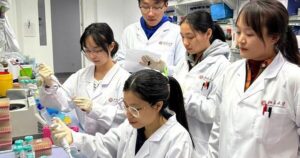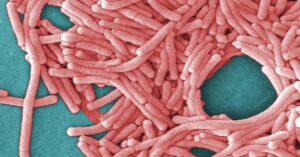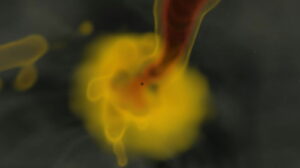
In a groundbreaking development, researchers have unveiled a new method to analyze the complex protein landscape of individual cells, offering unprecedented insights into cellular functions and disease mechanisms. This advancement, spearheaded by scientists from the Finsen Laboratory at Rigshospitalet, the Biotech Research and Innovation Centre (University of Copenhagen), the Technical University of Denmark (DTU), and the Helmholtz Zentrum München, could revolutionize our understanding of health challenges such as cancer and neurodegenerative diseases.
The study, set to be published on August 21 in the journal Science, employs a novel technique called single-cell proteomics by Mass Spectrometry (scp-MS). This method bypasses traditional RNA intermediates, providing a direct map of proteins present in cells during their differentiation from stem cells into mature blood cells. This innovation allows researchers to distinguish between cellular variants that might otherwise remain undetected, paving the way for new medical solutions.
Understanding Cellular Identity and Disease
For over a decade, scientists have focused on decoding genetic expressions at the single-cell level to understand cellular identity and its deviations, which are often implicated in major health challenges. The identity of a cell and how it can go awry is critical to its role in diseases like cancer, genetic disorders, and neurodegeneration. By zooming in on single cells, researchers can differentiate between variants that might be lost in broader analyses.
Traditionally, single-cell gene expression experiments have relied on single-cell RNA sequencing (scRNA-seq) to map gene activity. However, scRNA-seq only provides a partial view, capturing the intermediate step between genetic code and proteins. Proteins, which execute most cellular functions, can vary in levels independently of their corresponding mRNA, influenced by factors like mRNA stability and protein degradation.
Overcoming Challenges with New Technology
The new approach developed by the research team allows for the analysis of proteins directly, overcoming the limitations of RNA-based methods. Bo Porse, a senior author from the Finsen Laboratory and the Biotech Research and Innovation Centre, explains the significance of this development:
“The process of cell differentiation is immensely complex, and we need to fully understand the nuances of what’s happening inside each cell at each stage of its life to address the cases when the process goes wrong. With this study, we’ve shown the feasibility of using this technology to accurately model the exact stages of gene expression, covering both mRNA synthesis and decay, and subsequent protein synthesis and decay throughout cell differentiation.”
This study marks the first application of scp-MS in a biologically relevant organ system, as opposed to lab-grown cell cultures. Although detecting every protein in each cell is not yet possible, the researchers successfully compared mRNA data from scRNA-seq with single-cell protein analysis. They found strong correlations in more differentiated blood cells, but less so in stem cells, suggesting changes in mRNA turnover or protein stability during differentiation.
Expert Insights and Implications
Erwin Schoof, co-senior author and head of the Cell Diversity Lab at DTU, highlights the transformative potential of this technology:
“This study is the culmination of many years of intense technology development. Not long ago, the idea of measuring thousands of proteins in single human stem cells from the bone marrow felt like science fiction. We never imagined we’d be able to apply scp-MS to something as complex and dynamic as the human blood system this soon. But here we are, finally able to access layers of biology that are completely invisible to RNA-based methods alone.”
The research team further investigated proteins that decreased in abundance during cell differentiation despite stable mRNA levels. By editing the genetic code to knock out these genes, they demonstrated a reduction in stem cell numbers, indicating these proteins are crucial for maintaining a healthy stem cell population.
Future Prospects and Broader Impact
Fabian Theis, Director at the Computational Health Center at Helmholtz Munich, underscores the broader implications of integrating RNA and protein measurements:
“By integrating RNA and protein measurements into a dynamic model, we can capture the full life cycle of gene expression in single cells. This helps us understand not just what’s written in the genetic script, but how it’s performed in real time. I’m excited about how these cell-resolved protein readouts are increasingly opening entirely new windows into cell biology.”
This breakthrough in single-cell biology represents a pivotal moment, enabling the direct measurement of proteins at single-cell resolution in primary human tissue. It opens new avenues for discovering hidden regulatory layers in development, disease, and regeneration—layers that RNA alone could never reveal. Much like telescopes have transformed our understanding of the cosmos, single-cell proteomics is now illuminating the intricate workings of life at a cellular level.






